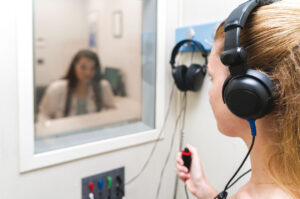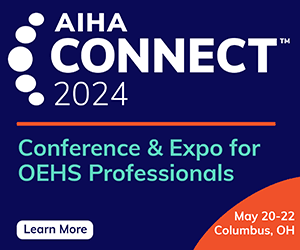The Council for Accreditation in Occupational Hearing Conservation: A 50 Year Perspective
By: J. Andrew Merkley, AuD, CCC-A, CPS/A, CAOHC Council Chair
As of August 2023, the Council for Accreditation in Occupational Hearing Conservation (CAOHC) celebrates its 50th anniversary of promoting best practices in occupational hearing conservation across the U.S.
Historical Perspective

In the 1990s and early 2000s, Council members developed the “Certified Professional Supervisor of the Audiometric Monitoring Program (CPS/A)” course and credential. © ATRPhoto – stock.adobe.com
The origin of the Council dates back to the mid-1960s, when the American Association of Occupational Health Nurses (AAOHN) reached out to the American Speech-Language Hearing Association (ASHA), the American College of Occupational and Environmental Medicine (ACOEM) and the American Industrial Hygiene Association (AIHA) to address the challenges of implementing comprehensive hearing conservation programs across the United States.
After meeting together, they formed the Intersociety Committee (IC) and developed the first Guide for Training Audiometric Technicians in Industry. From 1965 to 1969, with the help of a federal grant, over 3,000 nurses, health professionals and industrial professionals completed training following the guidelines set forth by the IC.
In 1972, the IC met with representatives of every important organization in the U.S. connected with the prevention of occupational hearing loss. A standing committee was identified and named the Intersociety Committee for Standardization of Industrial Audiometric Technician Training and Hearing Conservation. The National Institute for Occupational Safety and Health (NIOSH) underwrote the formation, development and the first-year operation of this organization.
In 1973, the name was changed to the American Board of Occupational Hearing Conservation Technicians. Later that same year, the name changed once again to the Council for Accreditation in Occupational Hearing Conservation (CAOHC).
The Council originally included representatives from AAOHN, ASHA, ACOEM, AIHA and the American Academy of Otolaryngology–Head and Neck Surgeons (AAO-HNS). In the years since the Council’s inception, the American Society of Safety Professionals (ASSP), the Institute for Noise Control Engineering (INCE), the American Academy of Audiology (AAA) and the Military Audiology Association (MAA) have joined the Council.
Best Practices
Today, each of these organizations remains strong in their support of best practices in occupational hearing conservation. The Council’s mission is to “Advance best practices in occupational hearing conservation worldwide through credentialing, standards, education and advocacy.” The Council’s vision is “a world without occupational hearing loss.” (CAOHC, 2023)
As the need to train certified occupational hearing conservationists (COHCs) grew, the Council expanded education programs to include train-the-trainer programs and, in the early 1980s, began training hearing technician instructors or Course Directors (CD). Later, in the 1990s and early 2000s, Council members saw a need to train professionals responsible by regulations to oversee hearing technicians and developed the “Certified Professional Supervisor of the Audiometric Monitoring Program (CPS/A)” course and credential.
Worldwide Reach
Today, there are 21,818 COHCs, 421 CPS/As and 321 CDs. The average number of COHC courses taught across the world each year is 983, certifying an average of 4,580 OHCs annually. There are currently COHCs in 42 countries; CPS/As in 13 countries; and the Council’s advocacy and standards committee is actively working with international occupational health organizations to promote CAOHCs mission and vision.
The Council has also developed other educational courses, such as the noise course and the hearing conservation manager (HCM) course. To date, over 156 students have successfully completed the noise course and 28 have completed the HCM course. Other educational material produced by the Council includes the Hearing Conservation Manual, now in its 5th edition, an anatomy video, a noise control video, a COHC Curriculum Guide and a COHC exam study guide.
On April 17, 2023, the Council entered into an official alliance with the Occupational Safety and Health Administration (OSHA). This alliance will, “provide members and the public with information, guidance and access to training resources that will help them protect workers by reducing and preventing exposure to occupational noise hazards…”
Personal Reflections

Audiologists assigned to Saudi Arabia during Desert Storm tested over 29,000 soldiers getting ready to come home in a month’s time. © Meysam Azarneshin – stock.adobe.com
To celebrate CAOHCs 50th anniversary, current and former Council members responded to questions about the greatest accomplishments and challenges over the past 50 years and future opportunities of the Council.
COL(R) Richard Danielson, who represented MAA from 1994-2001 and then AAA from 2003-2007 and served in multiple positions on the CAOHC Executive Committee, including Chair of the Council in 2005, reflected on the early challenges in training hearing technicians and in the military. Due to the high cost of travel and registration, he was tasked with figuring out a way to get every Army audiologist certified as a CD. They chose the Military Audiology Short course (MASC) as the training venue; developed training materials; and petitioned the Council to allow them to conduct the first CD workshop not conducted by CAOHC.
At the time, the military was not represented on the Council. It was approved, and training occurred at Fitzsimons Army Medical Center with about 40 audiologists completing the training. Danielson also recalled being one of the first audiologists to deploy in support of Operation Desert Storm and conducting an OHC course in the deserts of Saudi Arabia using ponchos as the chalk board.
The “Saudiologists” tested over 29,000 soldiers getting ready to come home in a month’s time. He believes CAOHCs greatest accomplishments over the last 50 years include development of certification for Professional Supervisors; recognition of CAOHC’s certification as the only legitimate national certification for OHCs; and collaborations with the National Hearing Conservation Association (NHCA) and NIOSH in programs that encourage best practices in hearing loss prevention. In the future, he’d like to see CAOHC tackle the challenges of virtual training, especially related to the hands-on practicum and improving training videos for audiometric technicians. (Danielson, 2023)
Dr. Laurie Wells, who represented AAA on the Council from 2007-2019, serving as Council Chair from 2015-2017, said, “I’ve had the unique opportunity to teach OHC courses in multiple countries in Europe, China and India, as well as PS courses in Mexico and Peru. CAOHC has created a reputation for best practices and a model that can be extended beyond the U.S. borders.”
Wells continued, “It is amazing to see the transformation of the students who often come to the course wondering how someone could talk about hearing for three days, and they leave the course with new appreciation for how much they have learned and how much there is to know.”
She sees CAOHCs greatest accomplishments over the last 50 years as “…gaining and maintaining recognition by regulatory agencies (OSHA, MSHA, etc.) as the authority for excellence in audiometry and hearing loss prevention; involvement of multiple professional disciplines in its governance; and course offerings and staying relevant over decades.” (Wells, 2023)
COL(R) Bruce Kirchner, who represented ACOEM from 2008-2019 and served as Council Chair from 2014-2016 said, “Probably the highest accomplishment actually was the founding of the organization by those who saw a need to improve hearing conservation and then went about establishing it.” He further stated, “I was proud to help expand CAOHC internationally through my position advocating hearing conservation in Proctor & Gamble (P&G). We did OHC and PS courses in Europe, Asia and Latin America. My colleague at P&G, Jorge Morales even took it further by offering courses outside P&G.” (Kirchner, 2023)
Looking to the Future
As CAOHC celebrates 50 years of excellence in occupational hearing conservation, the Council looks forward to the next 50 years of opportunity to advance best practices in occupational hearing conservation; developing and improving collaborations with national and international organizations with similar aims; and fulfilling the Council’s vision of “a world without occupational hearing loss.”
References
CAOHC. (2023, August 4). Mission and Vision. Retrieved from CAOHC: https://www.caohc.org/about-caohc/mission-and-vision
CAOHC. (2023, February 1). OHC Handbook and Instructions. Retrieved August 4, 2023, from CAOHC.org: https://www.caohc.org/UserFiles/OHChandbookandInstructionsFeb.2023.pdf
Danielson, R. (2023, July 25). (J. A. Merkley, Interviewer)
Kirchner, D. B. (2023, July 4). (J. A. Merkley, Interviewer)
Wells, L. (2023, July 6). (J. A. Merkley, Interviewer)
Share on Socials!
Wearables in the Modern Workplace
Testing, Testing… Importance of Proper Functional Testing in Gas Detection
Selecting the Right Respiratory Protection
Leaders in Industrial Hygiene
Council for Accreditation in Occupational Hearing Conservation (CAOHC)
Subscribe!
Sign up to receive our industry publications for FREE!









